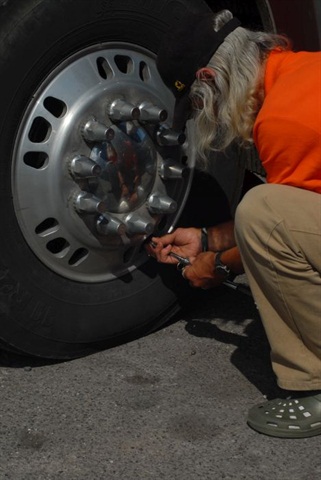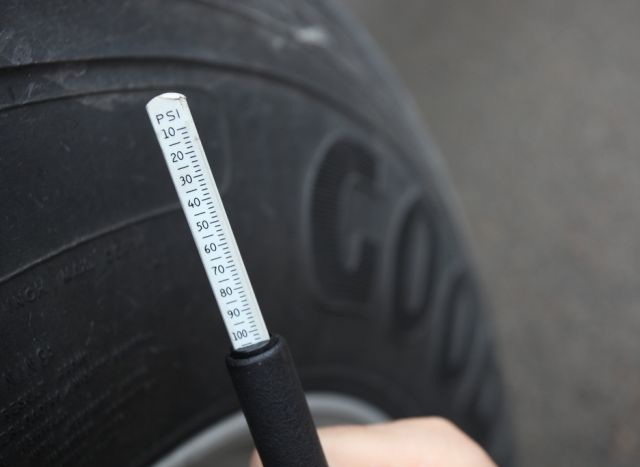If you are not running at least 105 psi in your steer tires, you’re running underinflated. In some cases, those tires may be in run-flat condition.
Most fleet maintenance managers know exactly why they spec a certain drive-axle ratio. That number is one part of a series of inputs that will get them to a certain engine speed at a certain cruise speed with an eye toward maximizing fuel economy.
But can they tell you why they inflate their tires to 100 psi?
Curtis Decker, manager of product development at Continental Tire North America, says the number has been around a long time, and its origins befit tires that were in service 20 years ago.
“The truth is inflating tires on 12,000-pound steer axle to 100 psi may have been okay 20 years ago, but it’s not enough anymore,” Decker says. “In most cases today a 22.5-inch low-profile, load-range G tire will get you to only 11,600 pounds at 100 psi. A tall ‘22-G’ will give you about 11,900 pounds of load carrying capacity. That’s still not enough.”
According to various manufacturers’ load and inflation tables, a typical standard-profile 11R22.5 LRG tire needs 105 psi to get beyond 12,000 pounds load carrying capacity. For example, Michelin’s tables indicate a pair of such tires would be good for 12,350 pounds (6,175 pounds each).
Low-profile 22.5-inch tires, such as a pair of 275/80R22.5 LRG, would need 110 psi (again, from Michelin’s tables) to carry 12,350 pounds. (You will find minor differences when comparing load and inflation tables across the major manufacturers, but they are small, and technical in nature.)
Back when they were still popular, long-nose conventional steer-axle loads seldom exceeded 12,000 pounds in normal on-highway service, so 100-psi inflation pressure was adequate.
Set-back steer axles shifted a larger percentage of weight forward, thus increasing steer-axle loads. And more recently, EPA emissions regulations added a bunch of emissions hardware to engines and chassis, adding another thousand pounds or so to the truck. Much of that wound up on the front axle.
“Steer axle loads have increased over the years, going beyond 12,000 pounds in some cases,”Decker adds. “Some manufacturers now install 13,200-pound steer axles in order to accommodate loads over 12,000 pounds. While actual steer-axle loads may not have reached that high in all cases, there are certainly some situations where loads come very close to that.”

The 13-2 axle adds a new dimension to tire selection. In cases where the operator may not be aware of the tire rating, they may still be inflating their LRG tires to only 100 psi. If their steer-axle loads are running at or close to the axle rating, the tires may be technically in run-flat condition.
Mike Beckett of MD Alignment in Des Moines, Iowa, gets a close look at trucks and their tires every day. He sees a shocking number of trucks coming through his shops with low-pro 22.5 LRG tires inflated to 100 psi on even 13,200-pound axles.
“The heavy steer axle is there for a reason,” Beckett says. “The manufacturer knows the front end of the truck is heavy, so they use an axle capable of carrying the weight. Often, those axles are loaded up to pretty close to that rating, so we know the tires are supporting close to 13,000 pounds or more. Yet, the tires on the axle at 100 psi are rated for no more than 11-5 or 11-6. If those axles are loaded, those tires could be running 1,000 or 1,500 pounds each over their rated maximum.”
Or viewed from another angle, the tires may be underinflated by 15 to 20 psi.
Load range G or H?
To solve the problem, you could reduce the load on the tire or inflate it more. But reducing the load on steer tires is impractical, and the load and inflation tables for most standard and low-profile 22.5-inch tires don’t allow for 13,200-pound loads. So the only remedy is a different tire: a 16-ply load range H tire inflated to 115 to 120 psi.
“The axle rating or maximum allowable load for an axle is not necessarily the normal operating load,” cautions Paul Crehan, director of product marketing at Michelin Americas Truck Tires. “Proper tire inflation pressure is dictated by the actual operating load of the vehicle and not the maximum allowable load for the vehicle. Proper steer tire selection, as well as tire inflation pressure, are linked to the specific conditions and applications of operations for that vehicle.”
Fleets should be auditing steer axle weights anyway, given how close steer tires usually run to their maximum weight rating for a given inflation pressure. Given most fleets’ reluctance to inflate beyond 100 psi, there’s probably a lesson or two to be learned from that process.
“The maximum load that a load range G tire can carry is 12,350 pounds,” says Donn Kramer, director of product innovation at Goodyear Commercial Tire Systems. “If the load is in excess of 13,000 pounds, a load range H tire inflated to 120 psi should be considered.”
But even a load range H tire won’t support a 13,000-pound load at 100 psi. A low-profile LRH tire will need at least 110 psi, some as much as 120 psi.
Funny thing about inflation
Pressures of 105 psi are fine with 12,000-pound steer-axle loads, but may be 10-20 psi underinflated in 13,200-pound steer-axle loads.

Fleets routinely over-inflate drive and trailer tires by about 33%, but they are reluctant to inflate a steer tire to its required pressure because it’s north of 100 psi.
“A low-pro 22.5 casing carrying 4,250 pounds requires a minimum inflation pressure of 75 psi,” Beckett points out. “Yet almost everybody runs 100 psi. They are overinflating by 33%, but they aren’t getting center wear. If you can over inflate 16 of your 18 tires by 33% and not get any unusual wear, why can’t you over inflate two steer tires by 10%?”
Actually, his use of “over inflate” isn’t accurate. You’re inflating the tire to the recommended pressure; it’s only our adherence to the arbitrary 100 psi paradigm that leads us to believe we’re over-inflating the tire.
Beckett says the recommended inflation will give you the standard fuel economy. If you’re 20% underinflated, it’ll cost you 1.5% in fuel economy.
The other factor to consider is seepage, Decker points out.
“I would never in good conscience tell a fleet to inflate drive and trailer tires to 75 psi, even though that’s what the load and inflation tables call for,” he says. “I know that tires pick up nails, rim and valve interfaces leak and a certain amount of air will diffuse through the liner of the tire. We know we’ll lose about 2% of our inflation pressure monthly when everything is working. At 75 psi we have no margin. I’m much more comfortable telling a fleet to inflate to 95 or 100. We are still well within the range of the tire, which with a load-range G tire would be 105 or 110, while a load-range H would be as high as 120 or 125 psi.
“In the steer position, it’s different, and this is where I think people fail to consider that a steer tire in its normal use will be loaded to 90-95% of its load carrying capacity on a regular basis. Even if you’re inflating to the recommended pressure, you’re leaving yourself no margin.”
We have thrown a lot of numbers around here. If you’re a little confused about the pressure you should be running in your steer tires, check the load and inflation tables. You’ll need to know the steer-axle weight rating of the truck, the actual loads you carry on the steer axle and the size of the tire in question. The make and model are important too, as recommended pressures do vary by manufacturer.
“On steer axles, 100 psi seems to be where most fleets are comfortable,” Decker says. “I’d love to see that become 115 to 120 psi.”






